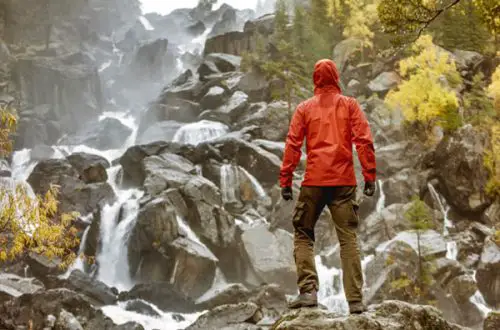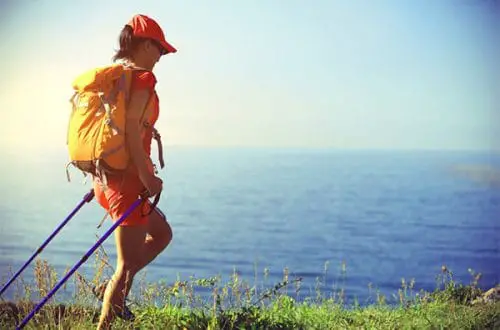Expert Advice: How to Choose Socks for the Outdoors
Table of Contents
We tend to not pay too much attention to the socks that we put on our feet. However, choosing socks for the outdoors is vital for any hiker or outdoor explorer.
Socks seem like a small detail yet they actually are vital in providing our feet comfort and stability during our walks or runs. For people who’ve experienced blisters and sores, well, they know all too well about foot injuries that occur when you’re not properly prepared.
A pair of socks can make all the difference, turning a hiking trip into a trip that you either only imagine in nightmares or a trip that belongs in a dream.
So, if socks make such a difference then what do you need to consider when purchasing a pair of socks? Well, in this article, you’re going to find out everything you need to know about the perfect pair of socks for any occasion and season. Read on!

What to consider in a pair of hiking socks
We’re going to be focusing on hiking socks as they’re the ones you’re going to be needing in the great outdoors. If you already found yourself the perfect hiking boot, you’re halfway done with protecting your feet.
Though many of us don’t know, there are many features that you need to consider when looking for an outdoor hiking sock. Though there are hundreds of thousands of different socks available on the market to choose from, most of them all offer the same features.
However, there are specific features that you’re going to need to be on the lookout for. These features can create a huge difference in the outcome of your hike and can turn a hike, as we said earlier, either into a nightmare or a dream.
Types of socks
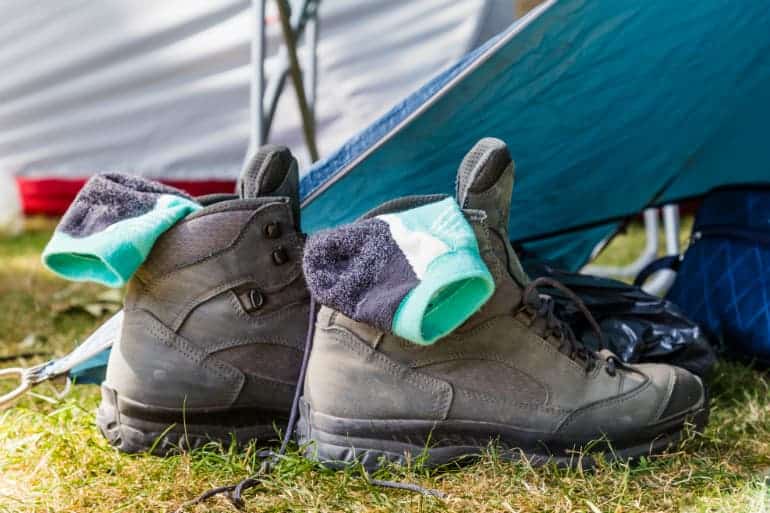
Let’s start with the basics. Before you even start looking up socks, you need to ask yourself a basic question: do you need a hiking sock?
Though the question may seem obvious, don’t be fooled as there are various types of socks on the market.
Most socks are designed with specific features for different activity levels, temperatures, and intensity. Let’s say that you’re going to be running. In this case, you’re not going to be looking for a wool sock. Rather, you’ll be opting for a thin and breathable sock that’ll keep your feet from becoming sweaty and smelly.
If you’re going to be mountaineering, naturally, you’ll be looking for a sock which is thick and well-insulated. So, let’s take a look at the various activities and which socks are ideal for each of them.
Hiking
When it comes to hiking, you’ll want socks which are designed to provide you with warmth, comfort, and breathability.
These socks tend to be high ankle socks or mid-calf socks that’ll be able to fit well with hiking boots. These socks are ideal for multi-day hikes as they’ll be able to provide you with extra protection against the rugged terrain.
The materials tend to vary as it depends on the temperatures and environmental conditions you’ll be hiking in.
Running
When it comes to running socks, they’re unlike anything else. These socks are typically ankle-height and are designed with the aim to provide you with comfort and breathability.
Usually, they’re much thinner than hiking or mountaineering socks because they’re focused on providing you with breathability rather than warmth.
Mountaineering
If you’re going to be mountaineering or skiing, then you’ll be looking for longer socks, ones which will be able to cover the calf area, ending just below the knee. They’re designed to fit snug inside your boots and can range in a variety of thickness.
Liners
These are used in partnership with thicker socks and are usually worn with mountaineering or skiing socks.
They’re focused to provide you with moisture-wicking features, thus, are ideal if you’re prone to blisters or cold feet. The liners are thin and are placed against the sock in order to prevent friction and skin abrasion.
At the same time, liners are also thin enough for moisture-wicking as it pulls the water away from the skin. Though, they’re not ideal for running or for use with tightly fitted hiking socks.
Fabrics
When you’re looking for socks, you need to focus on the materials that are being used. The materials used with each sock are meant to support the specific climate and condition you’re hiking in.
Each material is slightly different with their own pros and cons. You simply need to see what you’re going to be needing your socks for and the season you’re going to be hiking in.
For example, some conditions will require you to have warmer socks while others will require you to focus on breathability.
When searching for the perfect hiking socks, you want to make sure that you stay away from cotton or cotton blends, especially if you want to hike for long periods of time or in cold conditions.
This is because cotton retains moisture, holding it close to the skin and fails to insulate when wet. If you’re wearing cotton, it won’t dry fast and could actually place you in life-threatening conditions if you’re in the cold.
This is why you need to opt for either Merino wool, polyester, or propylene. Also, make sure that there’s either spandex, nylon, or lycra in the socks as well as these materials will give you some stretch.
Merino Wool
Merino wool is a natural material and is specifically designed for breathability, comfort and durability.
Merino wool comes from merino sheep which are found in New Zealand and Australia. What puts Merino wool on an entirely different level than other materials is its comfort and weight. Merino wool is considerably lighter than traditional wool, it also breathes much better and doesn’t itch which is a huge reason why people tend to stay away from wool altogether.
It’s quite durable and can withstand a wide range of temperatures, meaning that during cold conditions, your feel will be kept warm. Typically, socks with high amounts of Merino wool tend to withstand conditions better than other materials.
Polypropylene
Polypropylene is similar to polyester as it is a polymer fiber. It has the same benefits as polyester but has better durability.
The big difference between polyester and polypropylene is that this material is hydrophobic and absorbs less water. Thus, if this material meets water, it’ll evaporate faster than polyester material. Which means, as a result, the material dries faster.
If you’re going to be in wet and cold conditions, you need to keep your feet dry. So, finding a polypropylene blend sock would be the best in this situation as it has exceptional moisture-wicking properties and increased breathability.
Polyester
If you’re not a fan of wool, you can opt for a polyester which is a synthetic material. Though people tend to frown at the idea of synthetic materials, they’ve come along way and have many benefits for hikers.
The synthetic fibers are more durable in comparison to organic fibers, thus, they’re highly durable and will keep their shape relatively well. They tend to dry faster than organic materials such as Merino wool and are a favorite for hikers who are hiking during the hot summer months.
If you have polyester socks, they’ll be able to withstand the heat. Though, for cold months, they don’t stand up against the cold as well as Merino wool.
Material Weight
When it comes to socks, they come in four different categories which are based on the thickness of the sock. By determining the temperature and environmental conditions, you’ll be able to choose a sock which will best support you. Once you have these factors settled, then you can select the proper sock.
Ultra-lightweight
Weather Condition: warm to hot weather
Best Uses: hiking, running, fastpacking
If you’re opting for an ultra-lightweight sock, then it’s most likely because you’re hiking in hot weather. These socks focus on breathability with minimal padding, making it the thinnest sock in these categories.
Lightweight
Weather Condition: warm weather
Best Uses: backpacking, biking, leisure activities, hiking
A lightweight sock is designed for warmer conditions and high-intensity activities. Not only are the lightweight, they’re also durable and focus on moisture-wicking properties and breathability. They do have less support and cushion at the sole and forefoot, which is fine. You would use these socks during warm weather without a liner.
Midweight
Weather Condition: cold to warm weather
Best Uses: hiking, backpacking
If you’re planning on going for a long trip or you’ll be hiking/backpacking during the spring and fall seasons, then you should opt for a midweight sock.
These socks are usually more durable than lightweight socks, yet, are still breathable, unlike heavyweight socks. They focus on providing you with comfort, warmth, and breathability.
Midweight
Weather Condition: Cold weather
Best Uses: Winter sports
A heavy-weight sock is designed with padding at the forefoot and heel area of your foot. With this design, it provides extra warmth in those areas.
The sock itself is usually made with a variety of materials as well. Though, these socks are typically less breathable in comparison to other weights nor do they wicker away moisture as well as lighter socks.
This is why you should opt for a dual sock system if you need a heavyweight sock as it has a built-in liner which will focus on pushing the moisture away from your skin, preventing blisters.
The Sock’s Fit
The key to happy feet is a properly fitted sock. You want to pay close attention to size guides and make sure that the socks you’re purchasing aren’t too big nor too small.
Make sure that you pay attention to whether or not the socks are for men or women as they differ in design. If your sock is too tight it’ll be highly uncomfortable while if your socks are too big, they’ll cause blisters.
If you’re able to try on different socks in the store that’ll help you see which size you need. If you’re buying your socks online, the sizing guides are usually accurate.
Comfort
If you’re going to be hiking, whether it’s a day hike or a multi-day hike, then you want to make sure your feet are kept comfy.
When looking for socks, make sure that there’s cushion provided in areas around your heels and toes with compression panels around the arches. Though you may not realize it, these cushions will provide you with extra comfort during your hike.
Now, for longer hiking trips, ones that last more than a couple of days, then you need to look for a medium-weight sock with a dual sock system. This will help you keep your feet warm and dry while also working to prevent blisters.
Insulation
If you’re going to be hiking or mountaineering in cold conditions, then you need to make sure your feet are kept warm, especially in wet conditions.
In this case, you’ll want to opt for wool materials as they do the best in terms of insulation. However, do note, wool does take longer to dry. This is just something you’ll need to make a decision on as you won’t be able to have both.
For cold and wet conditions, it’s ideal if you wear a liner for extra warmth, paired with a heavy wool sock as that will help wick moisture away from your feet.
Drying Speed
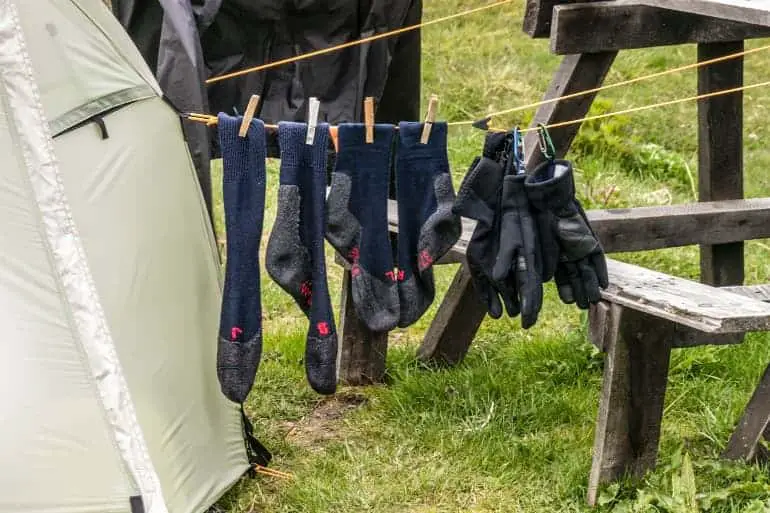
Let this be a rule of thumb: the thinner the sock, the faster it dries.
Naturally, you want your sock to be quick drying, however, if you’re going to be mountaineering, you cannot expect your socks to dry within seconds. You will not be able to find a quick-drying sock without sacrificing insulation – sorry to break the news to you.
Thus, you need to decide which you need more: insulation or dryness. If quick-drying is important to you then it’s best to focus on a synthetic sock instead of natural wool.
Moisture-wicking properties
Remember, the most important thing is keeping your feet dry, especially if you’re in cold environments. Usually, socks contain some nylon blends which aid with moisture-wicking, however, it takes away from insulation.
If you’re going to be hiking in cold environments and need warm socks, opt for Merino wool, however, to aid with moisture-wicking wear a liner as well.
Length
As you know, socks come in a variety of sizes and lengths. This isn’t because of fashion, this is because each length serves a specific purpose. If you’re looking for a hiking sock, you’ll notice that they’re generally ankle-length or halfway up the calf. This design is to prevent chafing around the hiking boot.
If you’re wearing a hiking shoe, ankle socks will provide you with a less bulky and breathable option. However, if you need a hiking shoe, opt for a boot as you’re given more protection and stability.
Gender Specific socks
Though this is the 21st century and gender is a thing of the past, it matters when it comes to socks. This is because men and women have differently shaped feet, thus, you need to purchase socks which are shaped for your feet.
If you’re having trouble differentiating which socks are for males and which are for females, look at the color. Typically, men’s socks are darker while women’s socks are bright and can come in patterns.
This is important as the construction of each gender’s socks are different. Typically, women have a more narrow foot with different width of heel to the ball of the foot ratio. This results in women’s socks designed narrowly with less material.
Durability
We get it – you want your sock to last. When it comes to durability, if you’re looking for a long-lasting sock, your best bet is to opt for merino wool with a high amount of nylon, lycra or spandex blend.
But, nevertheless, the best way to get yourself a durable sock is if you invest in them. You know the saying, you get what you pay for?
Well, it’s no different when it comes to socks. They’re essential for your hiking trip so it’s best if you spend a couple of extra dollars and get yourself a real pair of hiking socks.
Toe socks vs. Traditional socks
Some people dislike the restrictiveness that socks can make you feel. If you’re one of these people, then you should try toe socks instead of traditional socks.
Toe socks essentially are shaped exactly like your foot, fitting around each individual toe. In essence, they provide your toes with more wiggle room and claim to increase stability as well.
Many toe sock companies state that their socks improve balance, posture, moisture control, toe alignment, and prevent blisters.
Seasonal socks
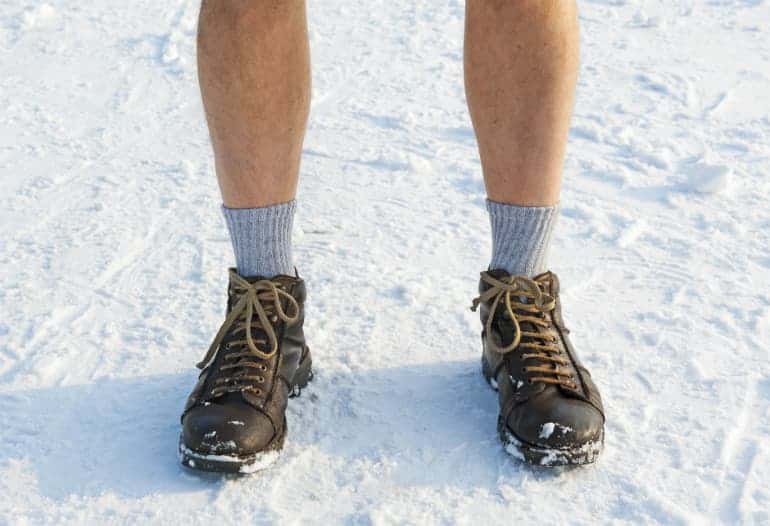
If you still need help selecting the right sock, maybe it’s easier to go by season. That way, you can see which season will require what so that you reduce the chance of injury and increase comfort.
Summer
If you’re going to be hiking during the summer, the weather will most likely be hot and with heat comes sweat.
This means that you’ll be needing to look for a sock with specific characteristics. You should look for a sock which provides you with comfort and cushion, however, is lightweight. The lightweight factor will keep your feet cool during the heat.
In addition, make sure your socks contain moisture-wicking fabric so that your feet can breathe and be kept dry at the same time. For this season, you’ll want to opt for synthetic socks such as polyester or polypropylene.
If you want a wool sock make sure it has either a nylon, lycra, or spandex blend. Again, if you’re going to be needing to wear socks in the summer make sure you stay away from cotton. Cotton will only bring you trouble as it’s not moisture-wicking and takes a long time to dry. Damp feet are a welcome party for foot fungus, odor, and of course, blisters.
Lastly, make sure that the socks match the terrain you’ll be hiking in. For example, if it’s bush you’ll need calf socks, whereas, if it’s flat or rocky terrain, ankle socks will do the trick.
Spring
Though it’s warmer than winter, it’s also wetter. During the spring season, you want to make sure your socks are kept dry and hold the heat in. Thus, you need to look for quick-drying socks made of synthetic materials and possibly a wool blend. During this season you’ll want to bring a couple extra pairs of socks as once your socks get wet, it can become dangerous. For this season, make sure you invest in a good pair of socks, ones with moisture-wicking properties and quick-drying characteristics as well.
Fall
Right after summer, the temperatures start to slowly cool down and everything seems to calm down from the intense summer heat. Now, you need to change your socks.
For fall weather, you’re looking for a sock that’ll provide you with the best of both worlds. You need a sock that’ll keep you warm but at the same time not make your feet overheat.
In this case, it can be a challenge and is sometimes even better if you bring extra socks with you that you can layer on if you’re feeling chilly. Or, you can purchase a three-season sock which is thicker than a summer sock, however, still provides you with the cushion that you need.
Winter
When winter arrives you feel it right away. It’s cold. This means that you need a thicker sock which is going to keep your feet properly insulated and comfortable during the cold conditions.
If you choose a sock which doesn’t provide proper insulation, you run the risk of catching hypothermia which can be lethal if you’re hiking. These socks are usually made of merino wool and come with thick liners.
Regardless of the activity, you’ll want a thick winter sock to keep your feet warm. Though at the same time, you want a sock which isn’t too thick that it’ll cut off circulation. Thus, when it comes to winter socks it’s best if you try them on with a hiking boot to get a better idea of how they feel.
You still may be thinking that socks aren’t that important. Well, it’s time you saw the bleak truth of what happens when you’re not wearing proper socks.
Foot conditions from ill-proper socks
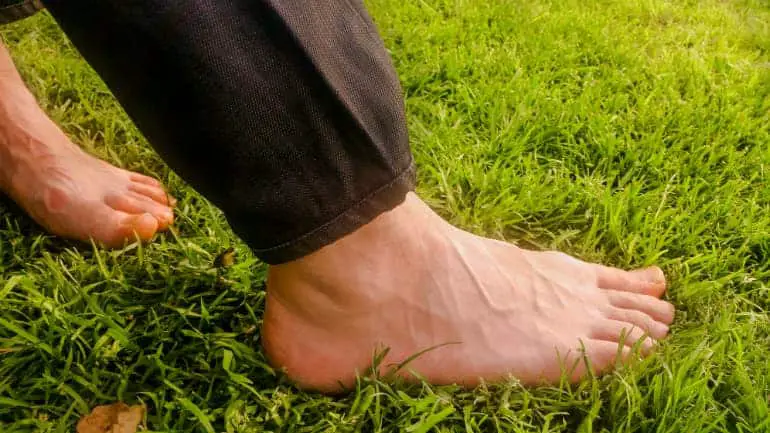
No one thinks that poorly chosen socks could cause foot conditions, but it’s true. It’s extremely important that you focus on wearing the proper footwear and socks.
Though you thought wearing the wrong shoes could cause you foot problems, you probably had no idea that these following conditions could be caused by wearing the wrong socks. Naturally, some of these conditions depend on the type of activity you’re engaging in while wearing socks as well.
Blisters
We all have had experience with blisters and this is why socks are so important! A blister is a small bubble which appears on the skin. It’s filled with a serum which is caused by friction. If your socks are ill-fitted and are too big for you, you’ll most definitely get a blister.
Toenail Fungus
Moisture-wicking properties in your socks are important for various reasons including this one. Nail fungus is an extremely common condition and forms as white or yellow spots under the fingernail. If the fungal infection grows, the entire nail will discolor and thicken.
This is caused by warm and damp environments, usually caused if you’re wearing damp socks for long periods of time.
Bunions
If your foot is receiving too much pressure, a bunion can be formed. This is caused when the bone or tissue at the joint of the big toe is moved out of place.
Naturally, this is formed after years of prolonged pressure and can become very painful. If your socks are too tight, plus, ill-fitted shoes, you’re in the making of having bunions. This is why it’s so important to select a sock which fits just right.
Hypothermia
In cold conditions, it’s life-threatening if your feet are kept in a wet environment. This is why you need to have a pair of socks which not only keep your feet warm but also dry.
Hypothermia is when your body loses more heat faster than it can produce, thus, causing you to have low body temperature. You’ll feel lethargic, confused and if left untreated, it is fatal.
Hammertoes
This is caused by wearing ill-fitted shoes and socks. This occurs when your toe joints become deformed, usually after prolonged use of small shoes. If your socks are too small, it also contributes to the condition.
Arch Pain
This is caused due to a lack of support from both your socks and shoes. When hiking for long hours, you need a pair of socks which come with arch support as you can easily strain your arches while hiking.
Who would have thought that this was possible, well, it is! Remember the next time you decide to choose a pair of socks without doing some research as they can cause you more trouble than you imagined.
How to take care of your socks
You paid for your socks so naturally, you want them to last you a long time, just like all your other hiking equipment. Your socks may come with a lifetime guarantee, however, you should still take the time to maintain your socks, keeping them in the best shape possible.
It’s best to look at the package and see if there are specific instructions for washing and caring for the socks. However, here are some general guidelines to help you keep your socks on tip-top shape.
- Do not bleach your socks, especially if they are made of wool. A bleaching agent will damage the wool fibres in the sock. If you have synthetic socks, it’s possible to bleach them, however, we don’t advise this.
- Make sure you wash your sock inside out as this will help to wash out any odor-causing bacteria. In addition, it’ll aid to reduce fluffing and piling which occurs when the socks rub against each other in the wash.
- If you’re going to dry your socks, we recommend you hang dry them. However, if you want to put them in the dryer, make sure the machine is set on tumble dry. If not, you run the risk of shrinking your socks during the drying process. If you’re going to hang dry them, make sure they’re hung in the shade.
- Some socks will show that you should warm them on gentle, however, ideally, you should be washing your socks by hand, inside out, with a mild detergent. Finally, you hang-dry them. This is the most ideal way of handling your socks.
Tips for choosing the best pair of socks
You don’t want to make the mistake of buying the wrong pair of socks. Sure, you can last for a day in them but if you have to wear them for multiple days, your feet are going to suffer. That’s why, when buying a pair of hiking socks, you need to follow these essential tips.
Think about the terrain
If you want your experience to run smoothly then you need to think ahead. Where are you going to be hiking? What will the terrain look like? It’s a simple question but it’s extremely important to know the answer.
Your equipment, in general, will rely heavily on the terrain you’re going to be facing. If you’re going to be expecting to walk to rugged terrain with hard rocks and minimal vegetation, then you’ll want a sock that doesn’t go above your ankle. However, if you’re hiking in the bush, then you’ll want a sock which goes the ankle, protecting your calves.
Bring spares
Regardless of the activity that you’re doing, you should always bring a spare pair of socks with you. There’s always the chance that your socks will become wet or that they’ll get a hole in them. This means you need to be prepared just in case. If you’re going for a longer duration, bring a couple of extra pairs to be safe.
Avoid cotton
Cotton is a huge no-no in the outdoor world. Regardless of the garment, you must stay away from cotton. There’s an important reason why.
Cotton doesn’t wick away moisture, instead, it holds it close to the skin and takes forever to dry. Not only will it weigh you down but it’ll also cause you injuries such as painful blisters. Once you have a blister, your hiking experience has turned into something you wish that would end.
Try them on with your boots
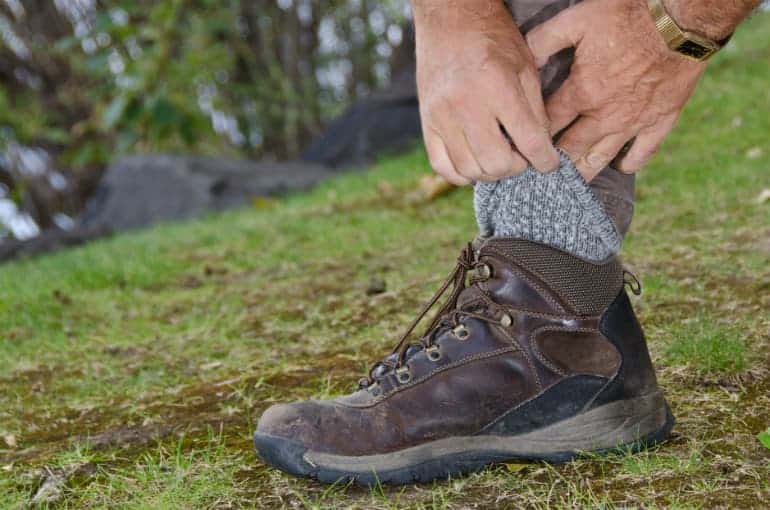
If you can try the socks on at the store, bring your boots with you. Or at least try them on with a similar boot to the one you have. You need to see how your foot feels in the sock.
Naturally, you don’t have to do this, however, it’ll make the hiking trip much easier knowing that you picked the right socks.
Think about the activity
What are you going to be doing while wearing those socks? Though it seems like a silly question, the activity you choose to do will greatly determine the type of sock you’re going to be wearing.
If you’re mountaineering, then you need a heavy sock whereas if you’re going to be hiking, then you’ll want a lighter and more breathable sock. To choose the right sock first look at what you’re going to be using it for.
Who thought socks would be so important! Well, they are and this means you need to pay extra attention to them when you’re looking for a pair.
Remember, when looking for a pair of hiking socks, make sure that you evaluate the terrain, the climate, and the activity you’re going to be doing. That way, you can select a sock which is going to suit your needs and not the other way around. Whether you’re hiking or mountaineering, you’ll be well protected and your adventure will be a positive one to remember.


